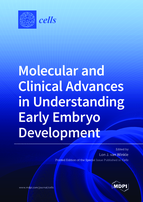Molecular and Clinical Advances in Understanding Early Embryo Development
A special issue of Cells (ISSN 2073-4409). This special issue belongs to the section "Reproductive Cells and Development".
Deadline for manuscript submissions: closed (15 November 2022) | Viewed by 41838
Special Issue Editor
2. Department of Medical Humanities, Rocky Vista University, Parker, CO 80122, USA
Interests: cell physiology; cell metabolism; development; cell differentiation; stem cells
Special Issues, Collections and Topics in MDPI journals
Special Issue Information
Dear Colleagues,
Both maternal and paternal environmental challenges and assisted reproductive technology (ART) can alter early embryo development. These molecular alterations often produce unwanted characteristics in adulthood. Included in the undesirable characteristics are metabolic syndrome, diabetes, hypertension, and other related disorders. Strikingly, these disorders may, in many cases, exhibit transgenerational expression. This special issue aims to explore current research concerning these and related environmental challenges to early embryos and their mothers and fathers. We invite submission of manuscripts concerning, but not limited to, the following key words regarding early embryo development.
We are pleased to invite you to contribute original articles, reviews, and communications, etc. We are looking forward to your contributions to this Special Issue.
Dr. Lon J. van Winkle
Guest Editor
Manuscript Submission Information
Manuscripts should be submitted online at www.mdpi.com by registering and logging in to this website. Once you are registered, click here to go to the submission form. Manuscripts can be submitted until the deadline. All submissions that pass pre-check are peer-reviewed. Accepted papers will be published continuously in the journal (as soon as accepted) and will be listed together on the special issue website. Research articles, review articles as well as short communications are invited. For planned papers, a title and short abstract (about 100 words) can be sent to the Editorial Office for announcement on this website.
Submitted manuscripts should not have been published previously, nor be under consideration for publication elsewhere (except conference proceedings papers). All manuscripts are thoroughly refereed through a single-blind peer-review process. A guide for authors and other relevant information for submission of manuscripts is available on the Instructions for Authors page. Cells is an international peer-reviewed open access semimonthly journal published by MDPI.
Please visit the Instructions for Authors page before submitting a manuscript. The Article Processing Charge (APC) for publication in this open access journal is 2700 CHF (Swiss Francs). Submitted papers should be well formatted and use good English. Authors may use MDPI's English editing service prior to publication or during author revisions.
Keywords
- metabolism
- biomembrane transport
- genetics
- epigenetic modifications
- transgenerational inheritance
- signaling
- ART
- in vitro culture
- trophectoderm
- inner cell mass







